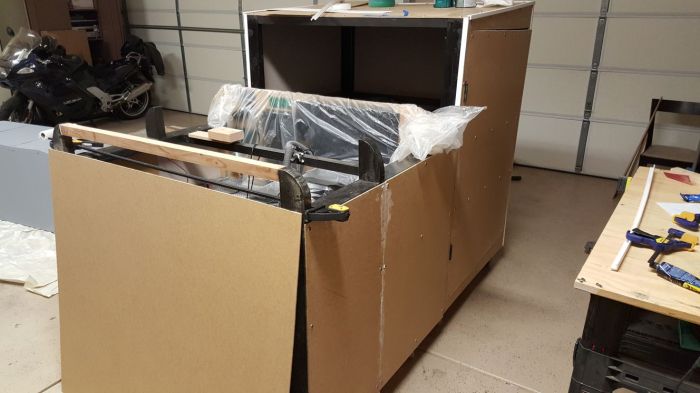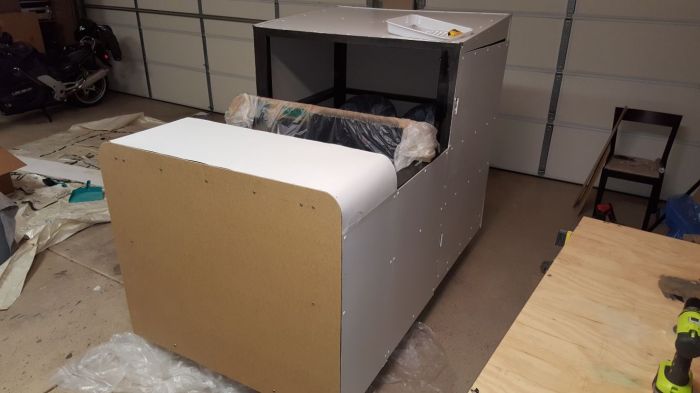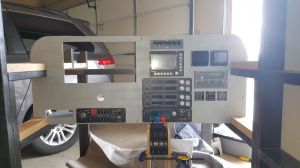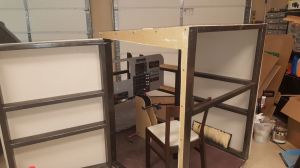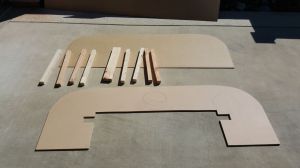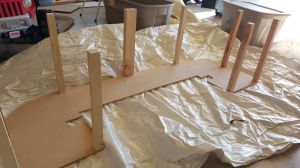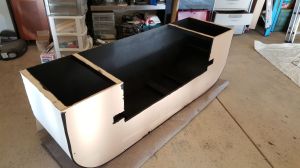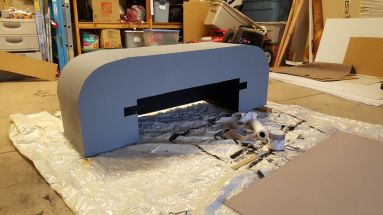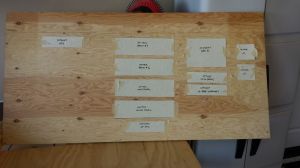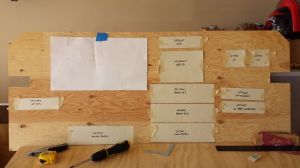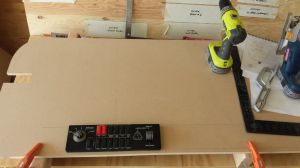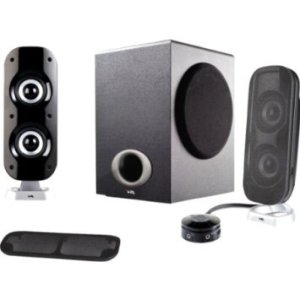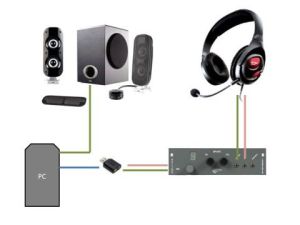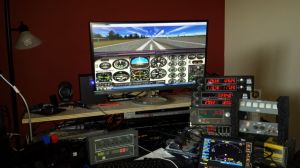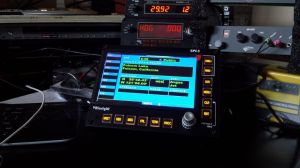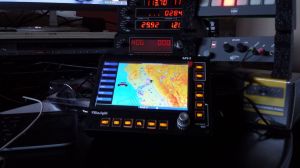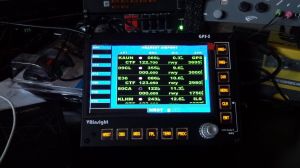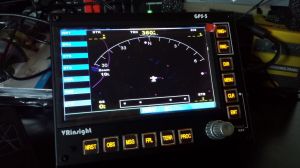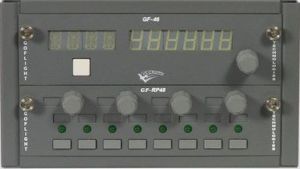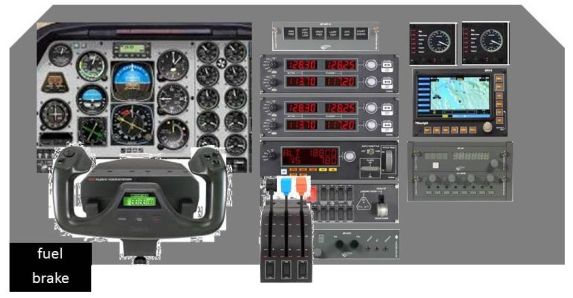Of course, this project will never be finished, but it has come to a kind of “beta” version anyway. I can happily fire it up and take it for a spin, everything seems to work, and it is a lot of fun.
Here’s a few photos of what it looks like at this stage:
Of course, this means I can now identify all the things I wish I had done differently. But those can go on to the “to do” list for the next iteration. Meanwhile, here are some thoughts on what I have discovered so far.
Too much stuff?
The panel has a lot of stuff, some of it isn’t totally useful, and some of it is redundant, but I’d rather have too much than not enough. But it does mean there’s room to add more panel functionality later on. However, right now, most of what I need is concentrated in about 3/4 of the gadgets.
In particular, two Saitek radios is overkill — I was thinking I would use one for COM1 and COM2 and the other for NAV1 plus something else. However, so far I have only used one radio: line 1 is COM1 and line 2 is an altimeter setting and transponder (thanks to FPUIC). The second radio ended up under the yoke for now — more on that below.
Button overload
From the outset, I had a goal of being able to fly around without touching a keyboard, except maybe to load and save the flight. Not only for all aircraft controls, but also things like pause, zoom, sim rate, etc.
To the end, I overloaded the cockpit with buttons, and left the programming to the end. That left me with a lot of button mapping to do. The best gadget for this was the 24-key X-Keys panel, which I mounted on the throttle quadrant. Right now it is about 50% utilized.
The yoke buttons are almost all unused so far, as are the rockers on the Saitek throttle quadrant (although I have plans for those). I also have a GF-48 with buttons yet to be programmed.
However, the more I fly, the more I identify things that would be handy to have assigned to a physical button (like “summon fuel truck”), so over time, utilization will increase – the only problem will be remembering them
VRInsight GPS-5 is great
My most favorite gadget. This thing works like a charm and is great for the type of flying I enjoy. Plus, it is really a good opportunity to learn the ins and outs of all its features, which should help if ever I come across a real Garmin GPS 500.
It was pretty easy to set up, and despite instructions to the contrary, also seems to work in full-screen mode too (not just windowed mode).
Lighting not so great
The inside of the cockpit is dark! This seems pretty obvious in hindsight. It was actually obvious as I built it, which is why I added a marine dome light in the roof (which features both red and white LEDs).
However, it turns out I need the dome light on all the time in order to see the various button and dial labels on things like the Saitek panels. Some actual panel lighting would be much better – maybe I can find a way to put a strip of LEDs along the header, and then use the dome light for looking at charts, etc.
The LED strip lighting that illuminates the footwells came out really good though, and adds a nice touch of ambiance.
GF-ATC
Another great gadget – I have the engine and environment sound piped through a 2.1 speaker system (and it can be pretty loud), but the comms go through a headset, which I plug in to the GF-ATC panel.
I can open and close the on-screen ATC window, as well as select any of the options, using just the GF-ATC and no keyboard, which is great. And although sometimes it feels like cheating to press “1” to set COM1 to the correct frequency, sometimes it is essential, since the Saitek radio only support two decimal places, whereas many frequencies have three.
But apart from that, I choose either “cheat mode”, and use the GF-ATC to select the numbered option in the ATC window, or I dial it in myself.
Construction details
There were a few construction details I left to the end, but didn’t get around to finishing. First, the door needs a latch to keep it closed (from the inside and from the outside). Second, the foot-wells need to be finished; right now you can peer down at your feet and see straight through to the “engine compartment” (i.e. the PC, subwoofer and a USB hub), which is mostly a problem on the passenger side.
Point of view
I knew this would be weird from the beginning, and after a few flights, it became very obvious.
The problem is, the cockpit is laid out with the pilot on the left side of center (like a real cockpit), but the view is drawn as if the pilot is in the middle of the view. This makes things like following a taxi line, or lining up with the runway centerline, kind of more difficult than it should be.
Now, I wanted the physical cockpit layout to be offset for sure, and figured I’d find a way to mess with the view later on. It turns out you can move the view point left and right, so I have been playing with shifting it so that the taxiway line, when it is under the nosewheel, lines up with the center of the yoke.
Frame rates
This will be another post all of its own one day. For now, suffice it to say I am still tinkering. Currently I get about 30 to 40 FPS over “open country” and about 20 over a crowded city. This is with the graphics options pretty much cranked all the way up, auto scenery on “dense”, about 20% air traffic, and almost no ground traffic.
More details to follow…
Add-ons
So far I have not tinkered with add-ons, except some scenery from OrbX: I am using their North America Northern California scenery, and one add-on airport (Lake Tahoe). Absolutely loving it so far, and can’t wait to add more airports. Oh, and I have their “FTX Trees” installed too.




